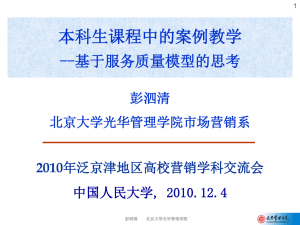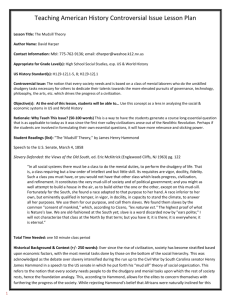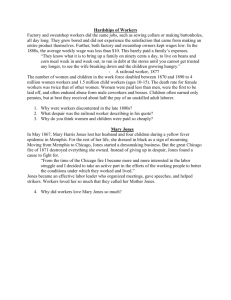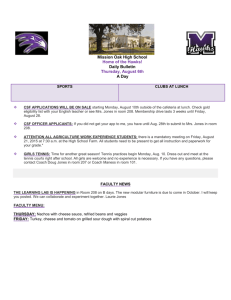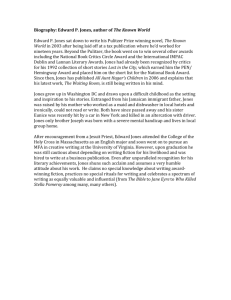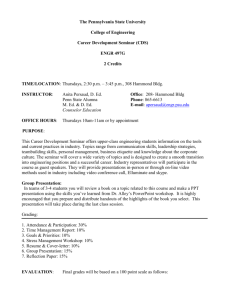A Brief History - Hampton School
advertisement
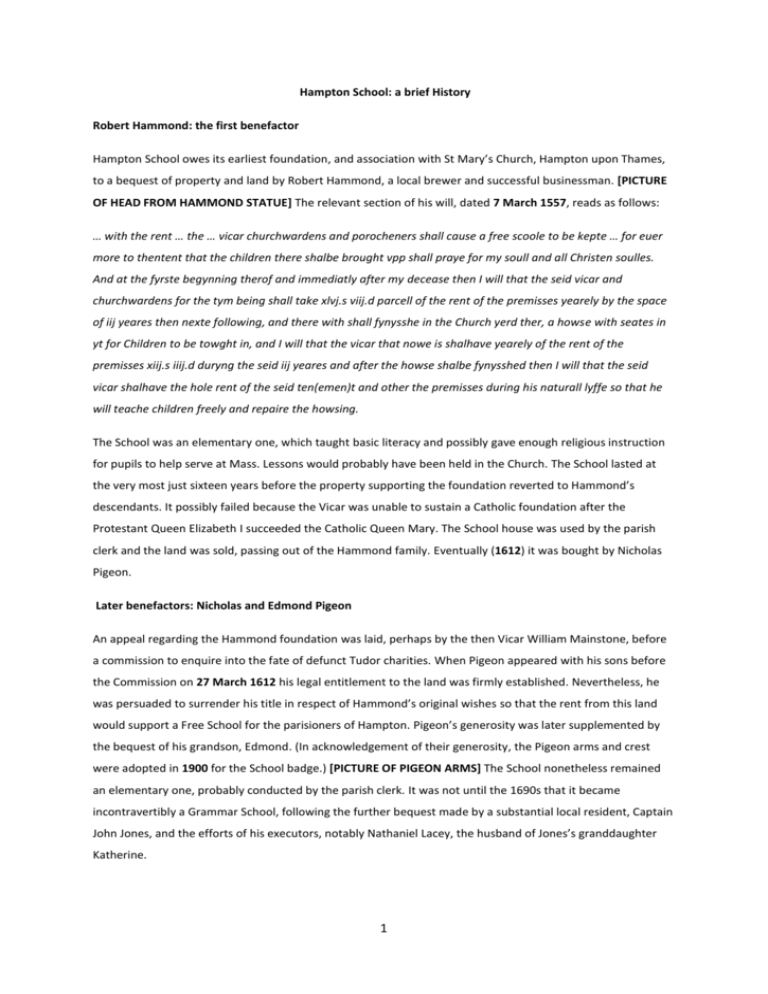
Hampton School: a brief History Robert Hammond: the first benefactor Hampton School owes its earliest foundation, and association with St Mary’s Church, Hampton upon Thames, to a bequest of property and land by Robert Hammond, a local brewer and successful businessman. [PICTURE OF HEAD FROM HAMMOND STATUE] The relevant section of his will, dated 7 March 1557, reads as follows: … with the rent … the … vicar churchwardens and porocheners shall cause a free scoole to be kepte … for euer more to thentent that the children there shalbe brought vpp shall praye for my soull and all Christen soulles. And at the fyrste begynning therof and immediatly after my decease then I will that the seid vicar and churchwardens for the tym being shall take xlvj.s viij.d parcell of the rent of the premisses yearely by the space of iij yeares then nexte following, and there with shall fynysshe in the Church yerd ther, a howse with seates in yt for Children to be towght in, and I will that the vicar that nowe is shalhave yearely of the rent of the premisses xiij.s iiij.d duryng the seid iij yeares and after the howse shalbe fynysshed then I will that the seid vicar shalhave the hole rent of the seid ten(emen)t and other the premisses during his naturall lyffe so that he will teache children freely and repaire the howsing. The School was an elementary one, which taught basic literacy and possibly gave enough religious instruction for pupils to help serve at Mass. Lessons would probably have been held in the Church. The School lasted at the very most just sixteen years before the property supporting the foundation reverted to Hammond’s descendants. It possibly failed because the Vicar was unable to sustain a Catholic foundation after the Protestant Queen Elizabeth I succeeded the Catholic Queen Mary. The School house was used by the parish clerk and the land was sold, passing out of the Hammond family. Eventually (1612) it was bought by Nicholas Pigeon. Later benefactors: Nicholas and Edmond Pigeon An appeal regarding the Hammond foundation was laid, perhaps by the then Vicar William Mainstone, before a commission to enquire into the fate of defunct Tudor charities. When Pigeon appeared with his sons before the Commission on 27 March 1612 his legal entitlement to the land was firmly established. Nevertheless, he was persuaded to surrender his title in respect of Hammond’s original wishes so that the rent from this land would support a Free School for the parisioners of Hampton. Pigeon’s generosity was later supplemented by the bequest of his grandson, Edmond. (In acknowledgement of their generosity, the Pigeon arms and crest were adopted in 1900 for the School badge.) [PICTURE OF PIGEON ARMS] The School nonetheless remained an elementary one, probably conducted by the parish clerk. It was not until the 1690s that it became incontravertibly a Grammar School, following the further bequest made by a substantial local resident, Captain John Jones, and the efforts of his executors, notably Nathaniel Lacey, the husband of Jones’s granddaughter Katherine. 1 Further benefaction: John Jones and Nathaniel Lacey Jones was born in Shrewsbury but probably soon moved to London where he became a prominent businessman and leading citizen. He was a staunch Parliamentarian (a Civil War captain), an MP and for a time was probably imprisoned in the Tower of London. When he died in 1692 the School was a considerable beneficiary of his will, but neither the original (drawn up 1691), nor the modifications of a subsequent codicil had been properly witnessed. [PICTURE OF JOHN JONE’S SEAL] They were therefore challenged by some of his relatives in the Prerogative Court of Canterbury. The Court initially awarded all of Jones’s real estate to these relatives, including the land and rectorial tithes which he had intended to provide for an ‘honest and able Schoolemaster’. However Jones’s executors appealed successfully with the result that that, in return for £264, this land was in 1696 conveyed to a body of trustees to be used as Jones had intended. Jones seems to have wanted merely to increase the endowments of Hammond’s School without elevating it from an elementary institution, but, by the terms of his will his executors had been left some discretion in the disposal of any funds remaining after all their obligations had been met. Accordingly in 1697 they bought three-quarters of the freehold of a property in Fleet Street (no. 14), housing the very popular Nando’s Coffee House. [PICTURE OF 14 FLEET STREET] Two of these quarters were transferred to the trustees just mentioned, the rental to be used to employ a man to teach local children ‘ the English and Latin Tongue and to understand the Catechisme now allowed by the Church of England.’ The specification of Latin raised the status of Hampton School to a Grammar School; and it was thus Jones’s trustees who laid the foundations for the type of school that exists today. The Upper Sunbury Road In 1828 the School was separated into Lower (or ‘English’) and Upper (or ‘Latin’) departments, each under a different master. These schools were initially housed together in a room adjoining the Church, erected in 1726 [PICTURE OF 1726 SCHOOLROOM] and replaced in 1833 by a building on the site of the current Parish Hall. [PICTURE OF 1833 BUILDING] The Latin School moved in 1880 to a new building in the Upper Sunbury Road [PICTURE OF UPPER SUNBURY ROAD BUILDING] while the English School took over all of the 1833 building. The Upper Sunbury Road site had come to the School along with a field extending to the River to compensate for the loss of rectorial tithes following the 1811 Enclosure Act. Much of the field was sold to the Southwark and Vauxhall Water Company, but the land to the north of the road was retained. For a variety of demographic and geographical reasons, maintaining this establishment proved increasingly beyond the financial means of the existing school trustees and the ability of the Headmaster to attract more and new pupils: despite Hammond’s original wish that the vicar might ‘teache children freely and repaire the howsing’, staffing and running costs meant that the School had now to charge fees. Therefore, since the Middlesex County Council was under pressure to extend its provision for secondary education in the area, rather than make a completely new beginning, it agreed, following the publication of a new scheme of 2 government in April 1910, to become a controlling Trustee of the existing school. The School thus became Hampton Grammar School, a name which is still used by older residents in the local area. Hanworth Road and the reversion to Independent status The Sunbury Road building and site were too constricted for the school to expand much beyond 500 pupils. Therefore, following lengthy deliberations, the School moved in 1939 to new, larger accommodation on the Hanworth Road, where it remains today. [1940s AERIAL VIEW OF NEW SCHOOL] The land here, commonly known as Rectory Farm, had also come to the School to compensate for the loss of rectorial tithes. Some of this land, not needed by the School, was sold to the Lady Eleanor Holles School and to the County Council to build the Rectory Secondary Modern School (now the Hampton Academy). There are therefore three schools today in the Hanworth Road. In line with its voluntary aided status, Hampton Grammar School relied on the Local Education Authority for its running costs and the provision of furniture and equipment, but its Governors were responsible for its endowments, premises and the general direction of the curriculum . In 1964 the Middlesex County Council was replaced as Local Education Authority by the London Borough of Richmond-upon-Thames. In 1970 the Borough Council passed a resolution ending 11+ selection in its schools. This was partly as a result of pressure applied by the Labour Government from 1965 on Education Authorities to plan for the reorganisation of secondary education on non-selective or comprehensive lines. The Borough’s plans envisaged the graduation of every primary pupil to an ’all-ability’ secondary school until the age of 16, after which those desiring further education could proceed to VIth Form colleges. Rather than lose its VIth Form the School reverted to independence in 1975. Since then it has continued to grow and flourish and celebrated its 450th anniversary in 2007 with a service in St Paul’s Cathedral. [CLOSING PICTURE OF 450 SERVICE IN St PAULl’S] 3
